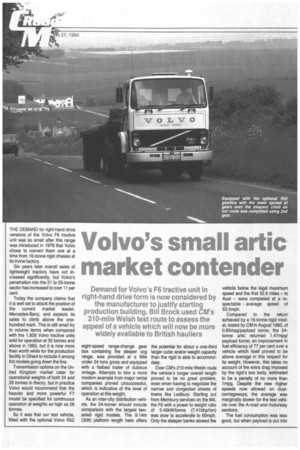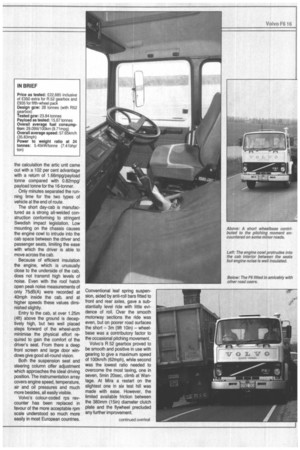Volvo's small artic market contender
Page 42

Page 43

Page 44

If you've noticed an error in this article please click here to report it so we can fix it.
Demand for Volvo's F6 tractive unit in right-hand drive form is now considered by the manufacturer to justify starting production building. Bill Brock used CM's 210-mile Welsh test route to assess the appeal of a vehicle which will now be more widely available to British hauliers
THE DEMAND for right-hand drive versions of the Volvo F6 tractive unit was so small after this range was introduced in 1978 that Volvo chose to convert them one at a time from 16-tonne rigid chassis at its Irvine factory.
Six years later overall sales of lightweight tractors have not increased significantly, but Volvo's penetration into the 21 to 25-tonne sector has increased to over 11 per cent.
Today the company claims that it is well set to attack the position of the current market leader, Mercedes-Benz, and expects its sales to climb above the onehundred mark. This is still small fry in volume terms when compared with the 1,928 Volvo tractive units sold for operation at 32 tonnes and above in 1983, but it is now more than worth while for the production facility in Ghent to include it among lhd models going down the line.
Transmission options on the United Kingdom market cater for operational weights of both 24 and 28 tonnes in theory, but in practice Volvo would recommend that the heavier and more powerful F7 model be specified for continuous operation at weights as high as 28 tonnes.
So it was that our test vehicle, fitted with the optional Volvo R52 eight-speed range-change gear box containing the deeper cog range, was provided at a little under 24 tons gross and equipped with a flatbed trailer of dubious vintage. Attempts to hire a more modern example from major rental companies proved unsuccessful, which is indicative of the level of operation at this weight.
As an inter-city distribution vehicle, the 24-tonner should include comparison with the largest twoaxled rigid models. The 9.14m (30f1) platform length here offers the potential for about a one-third larger cubic and/or weight capacity than the rigid is able to accommodate.
Over CM's 210-mile Welsh route the vehicle's longer overall length proved to be no great problem, even when having to negotiate the narrow and congested streets of towns like Ledbury. Starting out from Membury services on the M4, the F6 with a power to weight ratio of 5.45kW/tonne (7.41bhp/ton) was slow to accelerate to 60mph. Only the steeper banks slowed the vehicle below the legal maximum speed and the first 52.6 miles — to Aust — were completed at a respectable average speed of 53.5mph.
Compared to the return achieved by a 16-tonne-rigid model, tested by CM in August 1980, of 0.83mpg/payload tonne, the 24tonne artic returned 1.47mpg/ payload tonne; an improvement in fuel efficiency of 77 per cent over a vehicle which itself proved to be above average in this respect for its weight. However, this takes no account of the extra drag imposed by the rigid's box body, estimated to be a penalty of no more than 1mpg. Despite the new higher speeds now allowed on dualcarriageways, the average was marginally slower for the test vehicle over the A-road and motorway sections.
The fuel consumption was less good, but when payload is put into the calculation the artic unit came out with a 102 per cent advantage with a return of 1.66mpg/payload tonne compared with 0.82mpg/ payload tonne for the 16-tonner.
Only minutes separated the running time for the two types of vehicle at the end of route.
The short day-cab is manufactured as a strong all-welded construction conforming to stringent Swedish impact legislation. Low mounting on the chassis causes the engine cowl to intrude into the cab space between the driver and passenger seats, limiting the ease with which the driver is able to move across the cab.
Because of efficient insulation the engine, which is unusually close to the underside of the cab, does not transmit high levels of noise. Even with the roof hatch open peak noise measurements of only 75dB(A) were recorded at 40mph inside the cab, and at higher speeds these values diminished slightly.
Entry to the cab, at over 1.25m (4ft) above the ground is deceptively high, but two well placed steps forward of the wheel-arch minimise the physical effort required to gain the comfort of the driver's seat. From there a deep front screen and large door windows give good all-round vision.
Both the suspension seat and steering column offer adjustment which approaches the ideal driving position. The instrumentation array covers engine speed, temperature, air and oil pressures and much more besides, all easily visible.
Volvo's colour-coded rps revcounter has been replaced in favour of the more acceptable rpm scale understood so much more easily in most European countries. Conventional leaf spring suspension, aided by anti-roll bars fitted to front and rear axles, gave a substantially level ride with little evidence of roll. Over the smooth motorway sections the ride was even, but on poorer road surfaces the short — 3m (9ft 10in) — wheelbase was a contributory factor to the occasional pitching movement.
Volvo's R 52 gearbox proved to be smooth and positive in use with gearing to give a maximum speed of 100km/h (62mph), while second was the lowest ratio needed to overcome the most taxing, one in seven, 5min 20sec, climb at Wantage. At Mira a restart on the slightest one in six test hill was made with ease. However, the limited available friction between the 380mm (15in) diameter clutch plate and the flywheel precluded any further improvement. Full use of engine revs for acceleration gave little regard to the indicated economical sector of the rev band, but constant-speed running over A-roads allowed the vehicle's progress to fit in with normal traffic Mow without causing abnormal obstruction.
Integral power-steering gave good response and provided sufficient feed-back without being heavy. While there were a couple of instances where the narrow restrictions of some of the more minor roads inhibited the free flow of travel they were no worse than might have been encountered with a rigid vehicle.
Under maximum brake applications on a dry track the drive axle showed a tendency to lock while the wheels of the front axle :just about continued to rotate. This basically unstable condition did not, however, result in jack-knifing and the full brake programme was completed at the three indicated speeds. On the road under gentler progressive applications the vehicle responded in a safe and controlled manner.
The F6 tractive unit is the only Volvo model to incorporate a butterfly type exhaust brake. It gave better retardation than I have experienced with the exhaust governor which is fitted to most Volvo models primarily as an aid to minimise smoke when starting from cold. There was none in evidence on starting the TD 60 B power unit.
On the basis of fuel efficiency there is a good case for moving up the weight range. While this has been a general trend over several decades it is perhaps a more significant step to change from rigid to articulated vehicle operaiton.
Price for price the 16-tonne F6 rigid with its much longer chassis and wheelbase, while in many respects similarly specified, is surprisingly £1,875 less than the tractive unit. Volvo explains this by claiming that both vehicles are priced to be competitive in the market place. It is not the most expensive lightweight tractive unit on the market.
Operation of a tractive unit means additional up front investment in the form of a semi-trailer, but this is an expense which may be written off over perhaps two to three times the life of the prime mover. Differences in road tax are proportional to operational weights — £850 for the 16-ton rigid and £1,150 for the 24-ton articulated vehicle.
Summary Volvo would be hard pressed to justify the price difference between its F6 rigid and artic models. Technically capable of operation at 28 tonnes, the articulated unit would loose some of its appeal for tritercity distribution work coupled to a tandem-axled trailer. As tested at 24 tonnes the six in-line 5.48-litre turbocharged diesel engine, rated at 131kW (178bph) at 2,800rpm, gave a good return in respect of fuel used and payload carried.
Acceleration from rest is slow even when maximum use is made of the engine revs, but the vehicle is able to keep up with the general traffic flow.
Manouverability in congested town traffic is no worse than with a long rigid vehicle. The ride was generally good but there was some experience of pitching when driven
Top: The cab interior is well planned for ease of control and instrumentation visability.
Above: A butterfly type exhaust brake is used with Volvo's 5.48 ultra TO 60 Et turborcharged diesel engine.
over rougher road surfaces.
The cab is well equipped; I liked the instrumentation, seats and trim. Noise ingress from outside is repressed to give the driver a quiet, comfortable environment in which to work.




















































































